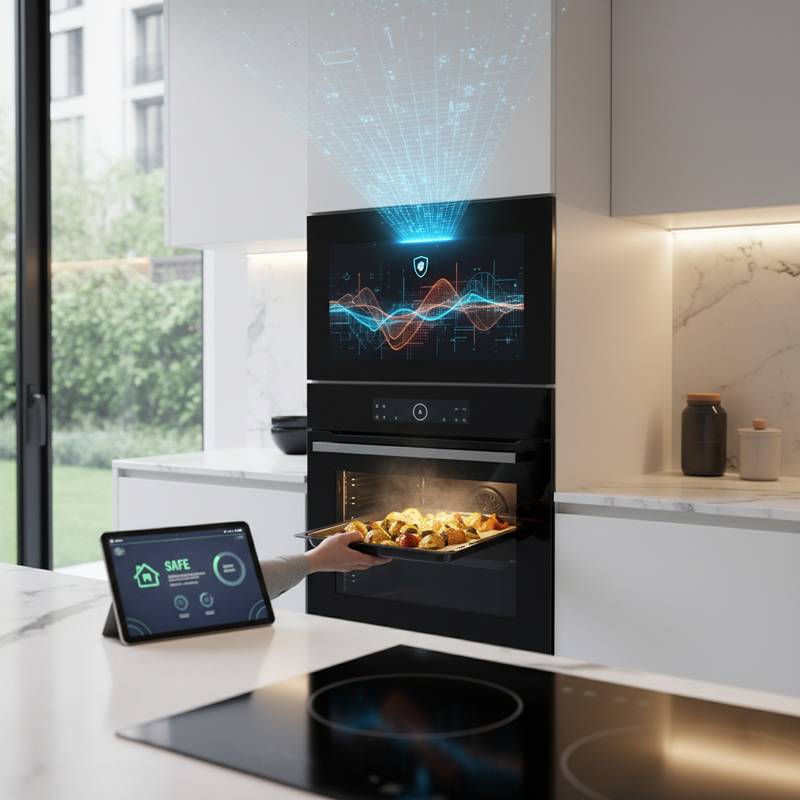How AI-Powered Smart Ovens Eliminate Kitchen Fire Risks
Nearly every household encounters a close call in the kitchen, from a forgotten casserole to a smoke-filled room during dinner preparations. Kitchen fires rank among the leading causes of home accidents, frequently sparked by unattended ovens. A new wave of smart ovens, equipped with artificial intelligence, sensors, and predictive analytics, addresses these dangers head-on by intervening before issues escalate.
These ovens function as vigilant assistants, monitoring conditions in real time and adapting to user patterns. They integrate seamlessly with everyday routines, offering not only enhanced safety but also streamlined cooking processes. As this technology evolves, kitchens transform into secure environments where accidents become rare occurrences.
Understanding Common Kitchen Hazards
Cooking brings joy and nourishment to daily life, yet it carries inherent risks. Conventional ovens demand constant oversight, from precise temperature settings to timely shutdowns. Moments of distraction or oversight can lead to overheating, which ignites fats or damages materials.
Safety data from organizations highlights unattended appliances as primary fire starters. Smoke alarms provide post-incident warnings but fail to address root causes. Smart ovens shift the focus to proactive measures, embedding intelligence directly into the cooking process.
This approach minimizes reliance on human vigilance, creating a buffer against everyday errors.
Evolution of Smart Oven Technology
Initial smart ovens emphasized user convenience, such as app-based preheating or voice-activated checks. Users valued the ability to monitor meals remotely. As capabilities expanded, developers incorporated multifaceted sensors for temperature, moisture, and activity detection.
Paired with machine learning, these features identify deviations like excessive heat buildup or prolonged operation. The outcome is an appliance that halts potential fires autonomously. This progression marks a shift from passive tools to active safeguards.
AI's Role in Enhancing Oven Safety
Artificial intelligence enables ovens to process data and make informed adjustments, mimicking skilled oversight. Through analysis of cooking histories, the system establishes baselines for normal operations and detects anomalies.
For example, during a baking cycle, if sensors register temperature surges beyond recipe norms, the oven reduces power or deactivates entirely. Alerts may prompt user confirmation via smartphone or integrated speakers. Brands including GE Profile, Samsung, and Whirlpool employ these algorithms to personalize safety protocols based on household behaviors.
Such systems prove invaluable for multitasking parents or seniors, providing reliable intervention without constant monitoring.
Sensor Technologies Driving Prevention
Sensors serve as the foundational elements, capturing data on heat distribution, air quality, and load status. Infrared imaging spots uneven heating that could signal hazards like accumulated residues. Chemical detectors sense early traces of combustion byproducts.
Weight mechanisms verify contents and trigger power-downs upon completion. Together, these tools form a vigilant network that assesses threats continuously. Upon detecting elevated risks, the oven activates cooling protocols or issues immediate notifications.
This layered detection ensures comprehensive coverage, far surpassing traditional safeguards.
Seamless Smart Home Connectivity
Smart ovens amplify their effectiveness within interconnected ecosystems. An overheating detection can activate exhaust fans or illuminate warning lights automatically. If users depart without deactivating the unit, linked security hubs deliver reminders or enforce shutdowns.
Standard protocols facilitate effortless device communication, eliminating setup hurdles. In connected residences, the oven contributes to a unified defense strategy, elevating overall home protection.
Leveraging Data for Continuous Improvement
These ovens refine their performance through aggregated, anonymized user data. Patterns revealing common overheating triggers prompt algorithm updates, benefiting all units. This shared learning fosters a dynamic safety framework.
Collaborations with insurers explore data-driven risk reductions, potentially yielding lower coverage costs. Pilot programs indicate significant declines in kitchen-related incidents among adopters.
Balancing Convenience and Security
Beyond protection, smart ovens streamline tasks with features like remote viewing and automated adjustments. Cameras provide live feeds, while databases tailor settings to specific recipes and quantities.
Prompts guide timing for interventions, such as basting or rotating. These elements intertwine safety with efficiency, allowing focus on creativity rather than constant checks. Users report heightened reassurance alongside practical gains.
Addressing Adoption Challenges
Premium pricing initially limits access, though competition drives affordability. Privacy concerns prompt robust security measures, including data controls and non-networked options.
Interoperability advances via common standards, simplifying integration with assistants like Alexa or Google Home. These developments broaden appeal, making advanced safety features attainable for diverse households.
Leading Innovations from Top Brands
Samsung's Bespoke line employs vision systems to recognize dishes and optimize cycles, averting thermal excesses. GE Profile integrates forecasting to maintain stable conditions. Whirlpool models deploy odor and particle sensors for preemptive halts.
Affordable variants, including countertop units, now incorporate these essentials, democratizing the technology.
Envisioning AI-Integrated Kitchens
Smart ovens herald kitchens as adaptive hubs, synchronizing with schedules and appliances for optimal flow. Coordination with refrigerators or ranges ensures balanced operations, from prep to cleanup.
Future enhancements will curb consumption, refine techniques, and promote nutrition via exact controls. Fire prevention evolves into holistic wellness support.
Practical Benefits for Home Cooks
Everyday users gain assurance in meal preparation, enabling independent use by youth or elders. Guidance refines techniques, minimizing errors and spoilage.
Many view these ovens as mentors, fostering skill development and relaxed routines.
Building Safer Kitchens Through Innovation
Widespread integration positions smart ovens as essentials, curbing incidents and inefficiencies. Ongoing refinements align with user priorities, solidifying the kitchen's role as a secure, intelligent domain.
